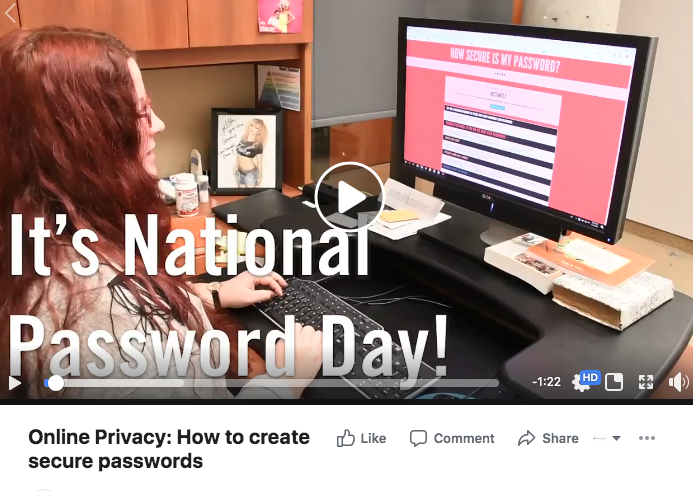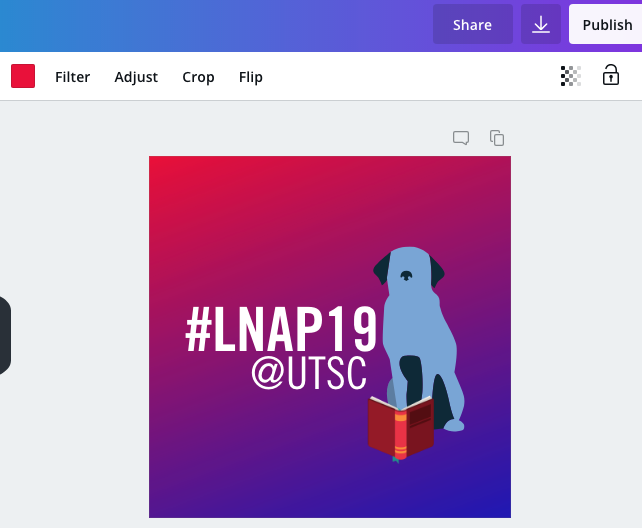Published on April 12, 2019
Written by Raquel A. Russell
Communications Assistant,
University of Toronto Scarborough Library
 It’s the end of the semester, so you may hear the collective sigh of relief taken by higher-ed communicators across the land.
It’s the end of the semester, so you may hear the collective sigh of relief taken by higher-ed communicators across the land.
You also may hear my slightly louder sigh of relief. I am now three months from my one-year anniversary as a communications assistant at the University of Toronto Scarborough Library.
Nine months FLEW by.
As our December blog writer Megan Weales wrote, this is my first full-time “adult” job where I get to assist in the creation and implementation of strategy and content.
Before taking this job, I worked in a role dedicated to article writing, photography and videography with a team of eight. After I transitioned to the multi-faceted (aka what-hat-do-I-wear-today) role of communications assistant, I learned five important lessons about the work we do and have made use of several tools that will carry me into my next season as a communications professional.
Lesson 1: To be a communicator means to collaborate
Throughout my involvement with three working groups and four event-planning teams, I’ve learned that no communicator has to be an island.
Two ways that I’ve actively implemented that “spirit of collaboration” is by
- reaching out to colleagues via Listserv or picking up the phone with questions about resources and processes, and
- regularly meeting communications colleagues across campus, grabbing a coffee and learning more about their unique department tasks.
Lesson 2: Don’t be afraid to take risks
During my first year, I played it safe with most tasks. I created tried-and-true content while getting comfortable with our department, resources and brand identity. As the semester started to wrap up, I decided to branch out by creating a video for National Password Day featuring a librarian that recently taught students about online privacy. That small risk earned us some of our most viewed content on Facebook!

Must-have tools
I moved from a role where my primary job was to create news content, including written stories, photos and videos — but wearing the hat of social media content creator was a bit daunting.
Why? As communications professionals, we know that content creation can take a lot out of you mentally.
These three lessons about tools helped me get through my first year as a content-creating communications assistant:
Lesson 3: Find a quick software to create graphics that you enjoy — and use it
As a team of one, part of my job is creating sets of digital and physical signage for events and workshops every month during the fall and winter semesters. With that comes some time-consuming tasks, such as resizing or redesigning graphics for Facebook, Twitter, Instagram stories and feeds, campus TV screens and more.
For me, Canva (a drag-and-drop format, graphic-design tool website) was a quick and painless solution for some of my learning curves on classic design tools such as Adobe Illustrator and InDesign.
I also use Canva to:
- Create templates for our Library Instagram stories (with a weekly story, titled “What’s Happening at UTSC Library” — inspired by a format on the U of T Libraries Instagram channel)
- Create gifs! (Yes, it’s possible, just beware of the large file size)
- Easily organize and update our department and campus brand identity items such as font, colour and logos
- Create fun pieces (like buttons!)

Lesson 4: Choose your social media managing tool, but don’t get stuck selecting when you can be creating
After starting my new role, I spent the expected amount of time familiarizing myself with our channels, content and the tools already at our disposal.
Then I made the mistake of obsessing over the perfect social media tool, comparing Hootsuite, Buffer and just plain old native sites. I made charts and consulted with colleagues.
I neglected to remember that Content is Queen.
All social media managing tools have their pros and cons. Choose the one the fits your immediate needs. You can even test a free version for a while (both Buffer and Hootsuite offer those opportunities) before making a final decision. Plug in your key national social media dates and holidays and get back to strategically creating your content.
Looking for quick (and free) social media monitoring/listening tools?
- Sign up for Twitter’s Tweetdeck, which allows you to create feeds dedicated to select search terms and accounts you want to always be aware of (such as your main campus accounts — in my case, that’s @UofT and @UTSC)
- Follow appropriate hashtags (i.e. #UTSC on Instagram and Twitter)
- Set up Google alerts
Lesson 5: Get started with basic video content creation programs
We know that 80 per cent of the content consumed online is through video. Whether you’re a team of five or, like myself, a team of one, don’t let video content creation scare you.
Check out PSEWEB’s very own Sarah Khan for excellent tips on how to DIY videos like a pro using software like Adobe Premiere Pro and iMovie.